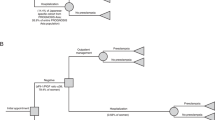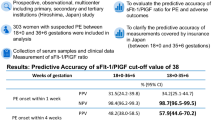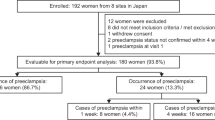Abstract
This retrospective study evaluated diagnostic and prognostic values of sFlt-1/PlGF ratio combined with serum endocan-1 for preeclampsia (PE). This study included 105 patients with PE admitted at Xiamen University Affiliated Xiang’an Hospital from January 2020 to September 2023, with 90 healthy pregnant women receiving routine check-ups during the same period as controls. sFlt-1, PlGF, and endocan-1 levels were measured, and sFlt-1/PlGF ratio was calculated. The correlation of sFlt-1/PlGF ratio with serum endocan-1 levels was analysed, and influencing factors for poor prognosis of PE patients were screened. Diagnostic and prognostic values of sFlt-1/PlGF ratio combined with serum endocan-1 were assessed. Results showed an increase in sFlt-1/PlGF ratio and serum endocan-1 levels in PE patients and a positive correlation between them. For assisting in the diagnosis of PE, the AUC of the sFlt-1/PlGF ratio combined with serum endocan-1 was 0.874 (95%CI: 0.819 − 0.917; sensitivity, 75.24%; specificity, 100.00%), which was superior over that of sFlt-1/PlGF ratio (P = 0.025) and endocan-1 (P = 0.047) alone. Elevated sFlt-1/PlGF ratio and serum endocan-1 levels were independent risk factors for poor prognosis of PE patients. For assisting in predicting poor prognosis of PE, the AUC of sFlt-1/PlGF ratio with serum endocan-1 was 0.955 (95%CI: 0.896 − 0.986; sensitivity, 82.61%; specificity, 100.00%), which was higher than that of sFlt-1/PlGF ratio (P = 0.023) or serum endocan-1 (P = 0.010) alone. Altogether, sFlt-1/PlGF ratio combined with serum endocan-1 is advantageous over sFlt-1/PlGF ratio and serum endocan-1 alone for predicting PE occurrence and prognosis.
This is a preview of subscription content, access via your institution
Access options
Subscribe to this journal
Receive 12 digital issues and online access to articles
$119.00 per year
only $9.92 per issue
Buy this article
- Purchase on SpringerLink
- Instant access to full article PDF
Prices may be subject to local taxes which are calculated during checkout




Similar content being viewed by others
Data availability
All data generated or analysed during this study are included in this article. Further enquiries can be directed to the corresponding author.
References
Phipps EA, Thadhani R, Benzing T, Karumanchi SA. Pre-eclampsia: pathogenesis, novel diagnostics and therapies. Nat Rev Nephrol. 2019;15:275–89. https://doi.org/10.1038/s41581-019-0119-6.
Rana S, Lemoine E, Granger JP, Karumanchi SA. Preeclampsia: pathophysiology, challenges, and perspectives. Circ Res. 2019;124:1094–112. https://doi.org/10.1161/CIRCRESAHA.118.313276.
Ives CW, Sinkey R, Rajapreyar I, Tita ATN, Oparil S. Preeclampsia-pathophysiology and clinical presentations: JACC state-of-the-art review. J Am Coll Cardiol. 2020;76:1690–702. https://doi.org/10.1016/j.jacc.2020.08.014.
Gatford KL, Andraweera PH, Roberts CT, Care AS. Animal models of preeclampsia: causes, consequences, and interventions. Hypertension. 2020;75:1363–81. https://doi.org/10.1161/HYPERTENSIONAHA.119.14598.
Dimitriadis E, Rolnik DL, Zhou W, Estrada-Gutierrez G, Koga K, Francisco RPV, et al. Pre-eclampsia. Nat Rev Dis Primers. 2023;9:8 https://doi.org/10.1038/s41572-023-00417-6.
Levine RJ, Maynard SE, Qian C, Lim KH, England LJ, Yu KF, et al. Circulating angiogenic factors and the risk of preeclampsia. N Engl J Med. 2004;350:672–83. https://doi.org/10.1056/NEJMoa031884.
Verlohren S, Brennecke SP, Galindo A, Karumanchi SA, Mirkovic LB, Schlembach D, et al. Clinical interpretation and implementation of the sFlt-1/PlGF ratio in the prediction, diagnosis and management of preeclampsia. Pregnancy Hypertens. 2022;27:42–50. https://doi.org/10.1016/j.preghy.2021.12.003.
Lala V, Franzese S. Role of sFlt-1/PlGF ratio in diagnosing preeclampsia. Am Fam Physician. 2024;109:470–1.
Stepan H, Galindo A, Hund M, Schlembach D, Sillman J, Surbek D, et al. Clinical utility of sFlt-1 and PlGF in screening, prediction, diagnosis and monitoring of pre-eclampsia and fetal growth restriction. Ultrasound Obstet Gynecol. 2023;61:168–80. https://doi.org/10.1002/uog.26032.
Jeon HR, Jeong DH, Lee JY, Woo EY, Shin GT, Kim SY. sFlt-1/PlGF ratio as a predictive and prognostic marker for preeclampsia. J Obstet Gynaecol Res. 2021;47:2318–23. https://doi.org/10.1111/jog.14815.
Ding G, Liping L, Moli D, Wuliyeti A, Shaohe Z, Huijuan W, et al. A study of the association between the sFlt-1/PlGF ratio and preeclampsia in Xinjiang Uygur Autonomous Region of China. Artif Cell Nanomed Biotechnol. 2018;46:S281–S6. https://doi.org/10.1080/21691401.2018.1491480.
Balta S, Mikhailidis DP, Demirkol S, Ozturk C, Celik T, Iyisoy A. Endocan: a novel inflammatory indicator in cardiovascular disease? Atherosclerosis. 2015;243:339–43. https://doi.org/10.1016/j.atherosclerosis.2015.09.030.
Bueno-Sanchez JC, Gomez-Gutierrez AM, Maldonado-Estrada JG, Quintana-Castillo JC. Expression of placental glycans and its role in regulating peripheral blood NK cells during preeclampsia: a perspective. Front Endocrinol. 2023;14:1087845. https://doi.org/10.3389/fendo.2023.1087845.
Kwiatkowska E, Stefanska K, Zielinski M, Sakowska J, Jankowiak M, Trzonkowski P, et al. Podocytes-the most vulnerable renal cells in preeclampsia. Int J Mol Sci. 2020;21:5051. https://doi.org/10.3390/ijms21145051.
Hentschke MR, Lucas LS, Mistry HD, Pinheiro da Costa BE, Poli-de-Figueiredo CE. Endocan-1 concentrations in maternal and fetal plasma and placentae in pre-eclampsia in the third trimester of pregnancy. Cytokine. 2015;74:152–6. https://doi.org/10.1016/j.cyto.2015.04.013.
Cakmak M, Yilmaz H, Baglar E, Darcin T, Inan O, Aktas A, et al. Serum levels of endocan correlate with the presence and severity of pre-eclampsia. Clin Exp Hypertens. 2016;38:137–42. https://doi.org/10.3109/10641963.2015.1060993.
Croke L. Gestational hypertension and preeclampsia: a practice bulletin from ACOG. Am Fam Physician. 2019;100:649–50.
Brown MA, Magee LA, Kenny LC, Karumanchi SA, McCarthy FP, Saito S, et al. Hypertensive disorders of pregnancy: ISSHP classification, diagnosis, and management recommendations for international practice. Hypertension. 2018;72:24–43. https://doi.org/10.1161/HYPERTENSIONAHA.117.10803.
Lee PF, Hsu TY, Tsai CC, Cheng HH, Lai YJ, Huang KL, et al. A comprehensive study of pre-eclampsia in IVF and natural conceptions: clinical phenotypes, perinatal outcomes and neonatal echocardiography. Reprod Biomed Online. 2024;49:103945. https://doi.org/10.1016/j.rbmo.2024.103945.
Muller A, Horvat V, Vulin M, Mandic S, Seric V, Vidosavljevic D. The soluble fms-like tyrosin kinase-1 (sFLT-1) to placental growth factor (PlGF) ratio as a possible indicator for the severity of preeclampsia - single institution experience. Med Glas. 2019;16:53–9. https://doi.org/10.17392/994-19.
Hentschke MR, da Cunha Filho EV, Vieira MC, Paula LG, Mistry HD, Costa B, et al. Negative correlation between placental growth factor and endocan-1 in women with preeclampsia. Rev Bras Ginecol Obstet. 2018;40:593–8. https://doi.org/10.1055/s-0038-1670713.
Chew BS, Ghazali R, Othman H, Ismail NAM, Othman AS, Laim N, et al. Endocan expression in placenta of women with hypertension. J Obstet Gynaecol Res. 2019;45:345–51. https://doi.org/10.1111/jog.13836.
Bacmeister L, Gossling A, Buellesbach A, Birukov A, Myers JE, Thomas ST, et al. High-sensitivity cardiac troponin I enhances preeclampsia prediction beyond maternal factors and the sFlt-1/PlGF ratio. Circulation. 2024;149:95–106. https://doi.org/10.1161/CIRCULATIONAHA.123.066199.
Lecarpentier E, Tsatsaris V. Angiogenic balance (sFlt-1/PlGF) and preeclampsia. Ann Endocrinol. 2016;77:97–100. https://doi.org/10.1016/j.ando.2016.04.007.
Hod T, Cerdeira AS, Karumanchi SA. Molecular mechanisms of preeclampsia. Cold Spring Harb Perspect Med. 2015;5:a023473 https://doi.org/10.1101/cshperspect.a023473.
Tataru-Copos AF, Popescu MI, Murvai R, El Kharoubi A. Efficiency of sFlt-1/PlGF ratio in preeclampsia diagnosis. Medicina. 2022;58:1196. https://doi.org/10.3390/medicina58091196.
Droge LA, Perschel FH, Stutz N, Gafron A, Frank L, Busjahn A, et al. Prediction of preeclampsia-related adverse outcomes with the sFlt-1 (Soluble fms-Like Tyrosine Kinase 1)/PlGF (Placental Growth Factor)-ratio in the clinical routine: a Real-World Study. Hypertension. 2021;77:461–71. https://doi.org/10.1161/HYPERTENSIONAHA.120.15146.
Gannoun MBA, Mehdi M, Zitouni H, Boussabah M, Zouari I, Jlali A, et al. Evaluation of the angiogenic factors sFlt-1, PlGF, and the sFlt-1/PlGF ratio in preeclampsia and associated features. Am J Reprod Immunol. 2023;90:e13715 https://doi.org/10.1111/aji.13715.
Villalain C, Herraiz I, Valle L, Mendoza M, Delgado JL, Vazquez-Fernandez M, et al. Maternal and perinatal outcomes associated with extremely high values for the sFlt-1 (Soluble fms-Like Tyrosine Kinase 1)/PlGF (Placental Growth Factor) ratio. J Am Heart Assoc. 2020;9:e015548 https://doi.org/10.1161/JAHA.119.015548.
Velegrakis A, Kouvidi E, Fragkiadaki P, Sifakis S. Predictive value of the sFlt‑1/PlGF ratio in women with suspected preeclampsia: an update (review). Int J Mol Med. 2023;52:89. https://doi.org/10.3892/ijmm.2023.5292.
Chen J, Jiang L, Yu XH, Hu M, Zhang YK, Liu X, et al. Endocan: a key player of cardiovascular disease. Front Cardiovasc Med. 2021;8:798699. https://doi.org/10.3389/fcvm.2021.798699.
Abreu MAD, de Castro P, Moreira FRC, de Oliveira Ferreira H, Simoes ESAC. Potential role of novel cardiovascular biomarkers in pediatric patients with chronic kidney disease. Mini Rev Med Chem. 2024;24:491–506. https://doi.org/10.2174/1389557523666230523114331.
Liu Chung Ming C, Sesperez K, Ben-Sefer E, Arpon D, McGrath K, McClements L, et al. Considerations to model heart disease in women with preeclampsia and cardiovascular disease. Cells. 2021;10:899. https://doi.org/10.3390/cells10040899.
Acknowledgements
Not applicable.
Funding
No funding was received for this study.
Author information
Authors and Affiliations
Contributions
SST, JLW are the guarantors of integrity of the entire study and contributed to the study concepts, study design, definition of intellectual content, manuscript review and editing; SST, JLW, LBH contributed to the the clinical studies, literature research; SST, LBH, LNZ contributed to the data acquisition; SST, JLW, LBH, AHP, LNZ contributed to the data analysis, statistical analysis, manuscript preparation, read and approved the final manuscript.
Corresponding author
Ethics declarations
Ethics approval and consent to participate
The ethics committee of Xiamen University Affiliated Xiang’an Hospital approved this study, which was performed in strict accordance with the Declaration of Helsinki.
Competing interests
The authors declare no competing interests.
Additional information
Publisher’s note Springer Nature remains neutral with regard to jurisdictional claims in published maps and institutional affiliations.
Rights and permissions
Springer Nature or its licensor (e.g. a society or other partner) holds exclusive rights to this article under a publishing agreement with the author(s) or other rightsholder(s); author self-archiving of the accepted manuscript version of this article is solely governed by the terms of such publishing agreement and applicable law.
About this article
Cite this article
Tian, S., He, L., Pan, A. et al. sFlt-1/PlGF ratio combined with endocan-1 serum levels improves the predictive values for the occurrence and prognosis of preeclampsia in a single centre study. J Hum Hypertens 39, 348–354 (2025). https://doi.org/10.1038/s41371-025-01009-5
Received:
Revised:
Accepted:
Published:
Issue date:
DOI: https://doi.org/10.1038/s41371-025-01009-5



